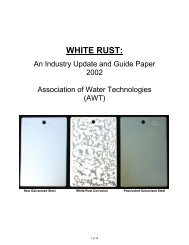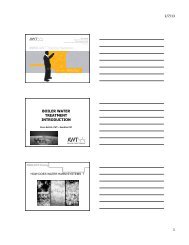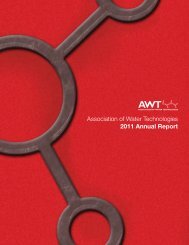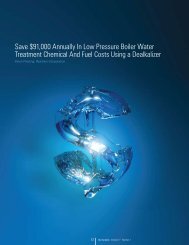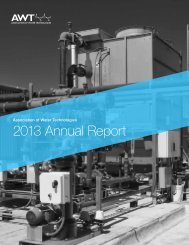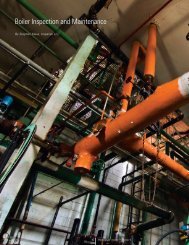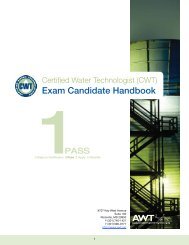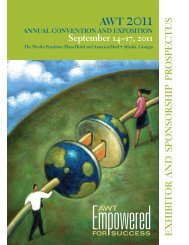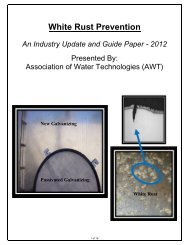Legionella: An Update and Statement by AWT - Association of Water ...
Legionella: An Update and Statement by AWT - Association of Water ...
Legionella: An Update and Statement by AWT - Association of Water ...
You also want an ePaper? Increase the reach of your titles
YUMPU automatically turns print PDFs into web optimized ePapers that Google loves.
<strong>Legionella</strong> 2003 – <strong>Update</strong> <strong>and</strong> <strong>AWT</strong> <strong>Statement</strong><br />
X. <strong>AWT</strong> Position <strong>Statement</strong> – <strong>Legionella</strong> & Legionellosis<br />
The <strong>Association</strong> <strong>of</strong> <strong>Water</strong> Technologies makes the following recognition <strong>and</strong> position<br />
statements regarding Legionnaires’ disease, water treatment <strong>and</strong> related practices <strong>of</strong> water<br />
treatment specialists. They are based on the significant <strong>and</strong> prevailing information from<br />
ASHRAE, CDC, CTI, EPA, OSHA, the medical community, leading experts <strong>and</strong> other<br />
authoritative agencies that study, investigate <strong>and</strong> deal with <strong>Legionella</strong> <strong>and</strong> Legionellosis.<br />
1. <strong>AWT</strong> recognizes the potential hazard for <strong>Legionella</strong> contamination in cooling towers <strong>and</strong><br />
evaporative condensers, as well as other water systems <strong>and</strong> water disseminating devices<br />
or equipment that may or may not be a part <strong>of</strong> water treatment programs.<br />
2. <strong>AWT</strong> supports that prudent operational <strong>and</strong> water treatment practices for cooling towers,<br />
evaporative condensers <strong>and</strong> other recirculating water systems, are consistent with reducing<br />
<strong>Legionella</strong> contamination within them <strong>and</strong> include:<br />
• Corrosion, scale <strong>and</strong> deposit control programs that promote operational efficiency<br />
<strong>and</strong> system cleanliness <strong>and</strong> reduce microorganism-breeding areas.<br />
• Dispersant, biodispersant <strong>and</strong> antifoulant programs that reduce bi<strong>of</strong>ilm, sludge,<br />
debris <strong>and</strong> dirt accumulations – that further reduce microorganism-breeding areas.<br />
• Biocide programs, including oxidizing <strong>and</strong> non-oxidizing treatments that are applied<br />
according to proper labeling, to control microbiological growth <strong>and</strong> proliferation.<br />
• Maintaining best available mist elimination technology in evaporative systems <strong>and</strong><br />
eliminating or minimizing stagnant (dead-leg) zones <strong>and</strong> areas.<br />
• A minimum annual (twice annual preferred) thorough wash-out <strong>and</strong> cleaning <strong>of</strong><br />
cooling towers <strong>and</strong> evaporative condenser cooling water systems - including an<br />
oxidizing disinfection before <strong>and</strong> after each cleaning.<br />
3. <strong>AWT</strong> supports that the microbiology <strong>and</strong> environmental ecology <strong>of</strong> <strong>Legionella</strong> includes<br />
many variables that determine organism virulence <strong>and</strong> survival, disease transmission <strong>and</strong><br />
contraction, <strong>and</strong> human host susceptibility. <strong>An</strong>d, even prudently applied water treatment<br />
programs cannot guarantee 100% <strong>Legionella</strong> eradication or disease prevention.<br />
4. <strong>AWT</strong> supports the sampling <strong>and</strong> testing for <strong>Legionella</strong> in cooling towers, evaporative<br />
condensers <strong>and</strong> other water systems appropriately risk-assessed <strong>and</strong> evaluated to pose<br />
disease risk. Specifically targeted systems include those that have a likelihood <strong>of</strong> harboring<br />
<strong>Legionella</strong> <strong>and</strong>/or pose an increased risk <strong>of</strong> transmission to populations <strong>of</strong> at-risk hosts.<br />
Monitoring for <strong>Legionella</strong> within a facility may also be appropriate or required to:<br />
• Verify the effectiveness <strong>of</strong> water treatment protocols,<br />
• Evaluate potential LD transmission sources,<br />
• Verify the effectiveness <strong>of</strong> <strong>Legionella</strong> decontamination procedures,<br />
• Test within certain healthcare facilities that have patients at high risk for LD.<br />
30




